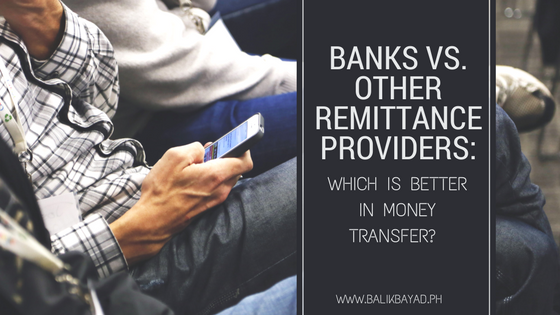 Sending money to their respective families in the Philippines will always be part of being an Overseas Filipino Worker. In fact, this is among the biggest considerations why you sought greener pastures. With hundreds of thousands of OFWs, it’s no surprise that banks decided to offer services specifically for OFWs, which includes remittance facility.
Sending money to their respective families in the Philippines will always be part of being an Overseas Filipino Worker. In fact, this is among the biggest considerations why you sought greener pastures. With hundreds of thousands of OFWs, it’s no surprise that banks decided to offer services specifically for OFWs, which includes remittance facility.
Let’s say you don’t have sufficient requirements that will meet the criteria set forth by banks to open an account. You seek help from money transfer companies who require less rigid requirements to be able to send money back home.
Here’s the question: which is better when it comes to money transfer – banks with tried and tested reputation or remittance providers who are more convenient and affordable? Read on to find out.
1) Banks need more information.
Did you know that not all banks have online wire transfer services? If you plan to remit money through wire transfer, you may be asked to fill out forms to facilitate every transaction. An ID is also required to validate your identity. You can skip this if you opt for remittance providers.
2) An account is required to allow remittances through banks.
Various banks have Savings Account facilities specifically for OFWs. You can use this account not just for savings but also to transfer money in the Philippines. On the other hand, you cannot avail of this service from banks if you don’t have an account with them. At the same time, banks only transfer to other banks as the receiving end.
Bank transfer is safer, but if you don’t have an account with them, you will have to look into other options such as MoneyGram, Xoom, or Western Union. They allow you to remit money back home even without any form of membership.
3) Remittance providers send money faster than banks.
If your family back home is in need of money and you want to send it immediately, then you might consider remittance providers. Bank wire transfers take longer to reach the recipient. Alternatively, there are remittance providers like Western Union that allow the recipient to receive the money in minutes.
4) When it comes to smaller transactions, remittance providers are more beneficial.
If you need to send small amount of money overseas, then remittance providers like Xoom and Western Union can be your best option. You can also avail of bank’s remittance facilities (if you have an account with them), although the exchange rate may be higher.
What if you need to send large amount of money back home? Bank transfer can be an option since it is safer. Nonetheless, you might also want to consider Forex companies since they offer favorable exchange rates at limited to zero costs. At the same time, the higher amount you send, the better the exchange rate will be.
5) Remittance providers have lower exchange rate.
Remittance providers can be more convenient; however, the exchange rate is generally lower compared to banks.
With these factors in mind, what do you think is the best way to send money back home? The answer is it depends on your needs. If you have an account with a bank that offers remittance facility, then maximize it. If you want to send money transfer, then remittance providers can be your best option, although the remittance fees and currency conversion costs are generally higher.

One Reply to “Banks vs. Other Remittance Providers: Which is Better in Money Transfer?”